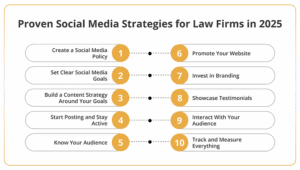If a potential client Googled your name right now, what would they find?
In 2025, your online presence will speak before you do, and social media is where most people go to check you out. Around 63.8% of the world’s population uses social media, spending an average of 2 hours and 19 minutes daily on these platforms.
Even in the legal industry, the shift is clear: 84% of law firms now maintain a presence on social media, and 29% of lawyers report getting new clients directly through it. If you are not showing up online, you are likely being overlooked, not because of your skills but because someone else is more visible.
Whether you are trying to attract new clients, build your reputation, or stay visible in a crowded market, social media gives you the platform to do it. You don’t need to be a tech expert to make it work; you just need a clear strategy and the willingness to show up consistently.
This blog will explain how your law firm can use social media to build trust, attract clients, stay compliant, and grow your practice.
Why Social Media Is Important for Lawyers?

Social media offers a powerful platform for lawyers to enhance their visibility, establish their expertise, and directly engage with potential clients. Here is why it is essential for your law firm:
-
Establishing Trust
Clients don’t usually search social media for a lawyer during a legal emergency. But you build familiarity and trust when you post regularly, whether it’s legal tips, Q&As, or case wins (without breaking confidentiality). That’s what makes people remember you when the need finally arises.
-
Targeted Visibility
Visibility matters. However, this should not be about posting for the sake of posting; it should be about being strategic. Short, clear tips, helpful videos, and thoughtful commentary get shared, increase your reach, and put your name in front of potential clients.
-
Brand Recognition
Social media helps you become more than just a name. It enables you to become a brand. Your online presence is often someone’s first impression of your firm. If your tone, visuals, and message are consistent, you’ll stay top-of-mind, even for people who don’t need a lawyer yet.
-
Enhancing SEO Organically
71% of lawyers say they generate leads directly from social media. Social media and SEO work hand-in-hand. Every post that links to your site is another chance to drive traffic and get found on Google.
To increase website traffic, consider linking your social media posts to helpful blogs, guides, or videos on your site. Encouraging backlinks is also beneficial; share content other sites might want to reference. For local SEO, include your name, address, and phone number (NAP) in your bios and posts. Use geo-tagging in your posts to improve visibility in local search results.
-
Engaging with Legal Peers
Social platforms, especially LinkedIn, let you connect with other attorneys, join legal groups, and stay in the loop on industry trends. Sharing your take on legal news or contributing to discussions helps position you as a thought leader and builds credibility in your niche.
Choosing the Right Social Media Platforms for Your Law Firm
Here’s a breakdown of social media platforms, their user demographics, and strategies for law firms to utilize them:
1. LinkedIn
LinkedIn is a professional networking platform for business-to-business (B2B) interactions, career development, and industry discussions. As of 2025, the largest age group on LinkedIn is 25-34 years old, comprising 47.3 %of its user base.
Use LinkedIn to showcase your expertise, build professional credibility, and connect with other lawyers, potential corporate clients, or referral sources.
Use a formal headshot. Your headline should go beyond just your job title — state how you help clients. For example: Litigation Attorney | Helping businesses resolve disputes efficiently. Fill out the About section with your key practice areas and wins. Articles, blog posts, or short takes on legal news. Post case studies, firm milestones, and speaking events. Also, share legal tips targeted at business owners or HR professionals.
Join and participate in legal or industry-specific groups. Comment on peers’ posts, endorse skills, and send personalized connection requests. Use hashtags like #BusinessLaw, #LegalMarketing, or #CorporateLaw.
2. Instagram
47% of American adults prefer using Instagram. This is your chance to show your firm’s personality and make legal info more digestible.
Use visuals and storytelling to connect with everyday clients. Use a branded logo or a friendly team photo. Add your location, practice area, and a link to your website or appointment form in your bio. Use Linktree or similar tools for multiple links.
Use Reels for quick legal tips (What to do if you’re in a car accident), carousels for step-by-step guides, and Stories to give behind-the-scenes looks at your firm. Share client wins (with permission) or testimonials. Respond to DMs. Use localized and practice-specific hashtags like #InjuryLawyerLA or #EstatePlanningTips.
3. TikTok
This platform is where short, engaging videos can help you connect with a younger or general consumer audience. Be concise, casual, and approachable.
Keep your handle simple and your bio very clear. For example, Chicago Personal Injury Lawyer | Tips to Protect Your Rights.
Focus on quick legal explainers (e.g., here’s what to do if you’re pulled over) and legal myth-busting. Use trending audio or formats when relevant, but keep it professional. Avoid heavy legal jargon.
Use the Q&A feature. Reply to comments with videos. Ask your followers what legal topics they want explained. Hashtags matter here: #LawTok, #LegalAdvice, or #TenantRights.
4. Facebook
Facebook remains one of the most widely used social media platforms globally.Sixty percent of lawyers and law firms using social media have a presence on Facebook.
Focus on reaching local audiences, sharing resources, and participating in community discussions. Ensure your page includes full contact details, services, and a booking or consultation link. Use a branded cover photo and highlight top posts with the pin to top feature.
Blog links, community legal updates, firm news, and explainer videos. Go Live for Q&As on relevant issues (e.g., What to Know About Estate Planning in 2025).
Join or create local Facebook groups (e.g., Small Business Owners NYC or Parents in Chicago). Respond to comments and use Messenger to answer common queries (or automate with FAQs).
5. YouTube
YouTube is the second most visited website globally, making it a powerful tool for content dissemination. Use YouTube to publish detailed videos on legal processes, frequently asked questions, and high-intent content that ranks in Google.
Use professional visuals, clean thumbnails, branded intros, and keyword-rich titles like How to File a Restraining Order in Texas. Your channel description should list your practice areas and location and provide a link to your site.
Explainers like 5 Steps in a Divorce, webinar replays, legal guides, and client Q&A sessions. Use playlists by topic for easy navigation. Ask viewers to comment or ask questions, then respond or make videos answering them. Use YouTube Community posts (if available) to share updates or polls. Prompt viewers to like/subscribe at the end of every video.
6. X (Formerly Twitter)
Twitter has approximately 388 million monthly active users, 14% based in the United States. Keep your bio tight and informative. Include your title, city, focus area, and a link to your firm’s site. Pin an introductory tweet or top article.
Live-tweet legal events (court decisions, new laws), comment on breaking news, or share quick legal facts in threads. Link to your firm’s articles or posts with sharp captions. Retweet industry news, comment on trending hashtags, and interact with journalists or legal analysts. Use practice-related hashtags (#SCOTUS, #EmploymentLaw, #CriminalDefense).
Proven Social Media Strategies for Law Firms in 2025

Here is an outline of crucial social media strategies your law firm should implement to stay competitive and why they benefit your practice.
1. Create a Social Media Policy
Before you post anything, establish clear guidelines for how your firm and its employees should behave online. A written social media policy protects your firm’s reputation and prevents accidental legal or ethical missteps.
Even personal posts can reflect on your firm. A good policy outlines your brand’s tone, what’s appropriate to share, how to avoid confidentiality breaches, and who is allowed to post. Refer to the ABA’s latest ethics rules and use templates.
2. Set Clear Social Media Goals
Decide what success looks like for your firm on social media. Use the S.M.A.R.T. framework: Specific, Measurable, Attainable, Relevant, and Timely goals.
Without a goal, you’re just posting for the sake of it. Goals help you stay focused and measure your progress. Common ones include improving brand awareness, getting traffic to your site, or increasing client inquiries.
3. Build a Content Strategy Around Your Goals
Consider what content will help you reach your goals and who you’re talking to. Random posts won’t get results. You need targeted content based on audience needs, pain points, and behavior.
Research your target clients, their legal needs, their preferred platforms, and what questions they ask. Analyze competitors to see what’s working in your practice area. Plan your post frequency based on platform best practices (e.g., 1-2 times/day on Facebook, once/day on LinkedIn). Use a content calendar to stay consistent and organized.
4. Start Posting and Stay Active
Once your profiles are set up and content is planned, start publishing. Active profiles build trust, while inconsistent or abandoned pages make you look unreliable. Regularly posting keeps your firm top-of-mind.
Use scheduling tools like Hootsuite, Buffer, or Sprout Social to automate your posting. However, keep room for spontaneous updates—especially when a legal news story is relevant to your practice.
5. Know Your Audience
Understand the people you’re trying to reach beyond age or job title. Knowing your audience helps you create content that resonates and answers real legal questions your clients are asking.
Gather insights on:
- Where your audience lives
- The types of legal issues they face
- Which content formats do they respond to (videos, FAQs, case studies, etc)
6. Promote Your Website
Every social profile should lead back to your website, where you can convert visitors into leads or clients. Your site is your digital HQ. It contains more detail than any post and should be the end point of your social funnel.
Add your website link to every social bio. Include CTAs in your posts that direct traffic (e.g., Read more on our blog or Book a free consult). Make sure your site is mobile-friendly and has contact forms ready.
7. Invest in Branding
Social media is visual, and branding matters. A consistent, professional look sets your firm apart, and a strong brand builds trust. People will likely take you seriously if your social media content looks polished and aligns with your firm’s identity.
Use a professional logo and header on all platforms. Create templates for social posts using tools like Canva. Stick to consistent colors, fonts, and tone of voice. Consider hiring a freelance designer or marketing agency if needed.
8. Showcase Testimonials
A few strong testimonials can go a long way in building trust. Hearing from happy clients is more convincing than anything you could say about yourself.
Ask clients for permission before posting. 2-3 testimonials that highlight specific wins. Share with context who you helped, their challenge, and how you solved it. Keep it balanced. Too many can feel like bragging.
9. Interact With Your Audience
Posting isn’t enough. Responding to comments, DMs, and shares builds trust and keeps the conversation going. Clients want lawyers who listen. Being responsive on social media shows that you’re engaged and available.
Check your messages and notifications regularly. Thank people for comments, and reply thoughtfully. Use negative comments as a chance to show professionalism and empathy.
10. Track and Measure Everything
What gets measured gets managed. After a few months, you should review what’s working and adjust your approach. Data shows you where to double down and where to pivot, keeping you from wasting time or money.
Track metrics like follower growth, website traffic from social, Engagement rate (likes, comments, shares), and leads or consultations booked
Monitor and analyze your performance using tools like Google Analytics or Sprout Social. Additionally, utilize platform-specific insights from LinkedIn, Meta, and other social media platforms to refine your strategies effectively.
Learn, Travel, Connect — Earn CLE Credits With Destination CLEs

Destination CLEs redefine the way legal professionals meet their continuing education requirements. Our conferences blend educational opportunities with cultural immersion in some of the world’s most captivating cities.
Why Choose Destination CLEs?
- Meet CLE Requirements: Fulfill your mandatory CLE credits through engaging, high-quality seminars in stunning global locations.
- Transformative Learning: This approach turns lecture-based learning upside down by engaging in sessions as dynamic as the destinations.
- Networking Opportunities: Connect with peers worldwide, expanding your professional network in settings that encourage collaboration and growth.
- All-Inclusive Experience: Enjoy comprehensive packages that cover educational sessions, accommodations, and unique cultural experiences, making your learning adventure seamless and memorable.
- Efficient Credit Earning: Earn required CLE credits efficiently, with schedules that balance professional development and exploration.
Recent Legal Tips & Travel Insights

Financial Planning for Lawyers and Law Firms: Secure Your Legal Practice

Why Attorneys Are Choosing Destination CLEs for Their Continuing Legal Education?

Social Media for Lawyers and Law Firms: 2025 Guide

7 Essential Tips to Improve Client Relationships in Your Law Firm

Best European Cities to Combine Work and Leisure While Attending a CLE

How to Overcome the Challenges of Managing a Virtual Law Firm?

The Complete Guide to Solo Travel for Lawyers: Tips, Tricks, and Essentials

Cybersecurity for Law Firms: How to Protect Client Data

CLE on a Cruise: Why It’s the Best Way to Earn Credits While Traveling

Weekend Getaways: How to Extend Your CLE Conference into a Vacation

How CLE Requirements Differ Across U.S. Jurisdictions for Lawyers?





